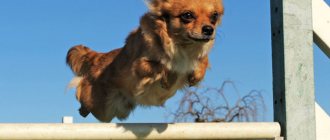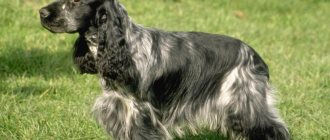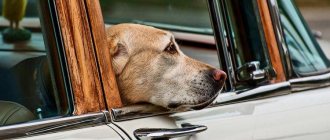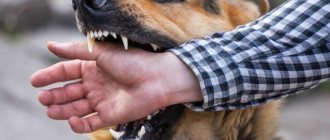Why do you need to train a dog?
Animals, especially dogs, not only can, but also need to be trained. The need for this arises not only among professional breeders or dog handlers who decide to train a dog to search for traces or certain odors, but also among ordinary citizens. Training helps:
- make the dog more obedient, pacify its tough temper (animals are very different, but discipline helps to cope with their unpleasant character traits);
- socialize the animal, improve its mental state;
- improve the dog’s guarding or hunting qualities;
- reduce the level of aggression towards humans and other animals.
Important! Pets are not always trained for the purposes outlined above; sometimes training helps them develop and consolidate certain playing skills. Dogs are often trained to perform all sorts of tricks for the enjoyment of the family or for display to the public.
Training a service dog to command “Toe” or “Nearby”
Is it possible to train an adult dog?
Dogs begin to be trained at a fairly early age, but even an adult dog can be taught some useful things, for example, not to steal food from the table, go to the toilet in a certain place, fetch a stick or slippers, and take a stance.
An adult dog will resist any attempts to change his behavior more than a puppy. But attention to detail and perseverance make it possible to turn a completely untrained sexually mature individual into a completely mannered and even noble one at first glance.
Train the dog yourself or contact a dog trainer
Puppies can be trained on their own, but adult dogs need a stronger will than their owner. Accustomed to a certain behavior towards him on the part of a person, he simply will not perceive the commands correctly. It is rare that a dog can be trained independently after it has reached the age of 1-2 years.
The help of a dog handler will undoubtedly be required. But here you need to take into account exactly what requirements the dog owner places on the pet, what he wants to teach it. So, if the task is solely to teach your pet the rules of catching a plate or giving a paw, then you can cope with this yourself, but important commands for each dog should still be taught by a professional.
Obedient, trained dog
Training small dogs
If you have a small dog, it will be easier to train than a large one. Since small dogs love to run at any age, the very first command may be “come to me.” This will definitely come in handy if your pet runs too far.
Usually small breeds become real members of the family. And so the next command should be "place". It is this that will allow you to teach your dog not to run on beds or sleep with its owners in the future.
You can also teach your dog the following commands: fu, next and restraint. These are the main tasks that a small breed dog should face.
General rules for self-training
If you still decide not to take your pet anywhere and raise it yourself, you need to write down or remember the following simple rules:
- training should take place in a deserted place, it is better if the owner and dog are left alone;
- commands are given in a firm, confident voice;
- You cannot pet or give treats to a dog that has not completed the assignment;
- you need to train regularly;
- the dog is rewarded for each action performed;
- You cannot shout or hit a dog that has failed to complete the task.
Important! Experts recommend using special incentives for each team. This will help the dog distinguish them not only by hearing, but also by smell or type of action. If food is used as a reward, then there is no need to allow the pet to eat to its fullest after each successfully completed action. There should be little food, literally a few small pieces. As you move forward, the result appears and consolidates, the reward after each completed command is refused.
Preparing for training
How to prepare:
- during training, they reward for correctly executed commands, so stock up on treats;
- The pet is gradually accustomed to the collar and leash. If the dog does not respond to the command, then the collar is strictly pulled;
- You need to attract the attention of a distracted dog with objects that make sharp sounds - a bunch of keys, a rattle, a whistle.
When dressing for a walk to train your pet, choose comfortable clothes that do not restrict movement, with a minimum of exposed areas of the body. An excellent choice is a special suit.
Before starting walks, you should clearly remember that it is important to show strength of character, but not aggression, and not to hit your pet. For failure to follow a command, he is not petted or praised. Exercise in a good mood, command in a cheerful, cheerful voice, and if it doesn’t go well and you get irritated, then it’s better to interrupt the walk.
Basic training methods
Both professionals and amateurs use training methods such as:
- Tasteful. To use it, the dog is not fed for about 3-4 hours straight before the start of training. A half-starved dog happily follows commands, hoping to get a treat or just food at the end of the lesson. Gradually, the dog develops a reflex to food. This method is used for training search engines, dogs in which the food reaction predominates, but is not used for future guard and guard dogs, animals trained with the aim of developing in them a reflex to apprehend criminals.
- Mechanical. The carrot and stick method. During training, the dog is influenced mechanically, for example, by whipping it with a twig, urging it to take action. At the end of the lesson, the dog is petted.
- Contrasting. Combines the two previous methods. Dogs that successfully complete the task are fed, and those that refuse to follow the commands are punished.
- Imitative. A dog imitates an animal or a person. The method is optional.
- Coaching. Using a set of stimuli, conditions are created that encourage the animal to carry out certain commands.
When training at home, it is reasonable to use contrast and taste reward methods, but dog handlers use all of the above. This allows them to achieve their goal faster.
The dog walks nearby, reacting to the owner
How to train a hunting dog
As for training hunting dogs, you will have to work on it. In such breeds, some manifestations of character should be suppressed. A hunting breed dog will not work without proper training and education.
The basics should be devoted to 6 to 9 months. During this period, dogs need to be trained to obey, taught clearly, not to follow commands and quit, and also trained to command me using a whistle or horn.
As early as 10 months, you can start learning special commands. That is, to accustom the dog to hunting. The connection between dog and hunter is important here. On the one hand, she should not be afraid of her owner, and on the other hand, she should be obedient and not get lost in different situations.
Hunting dogs have the ability to accumulate experience and compare behavior, so such an animal should not be treated as a collection of reflexes. Hunting breeds are characterized by the presence of powerful intelligence.
How dangerous is lichen in dogs and how to deal with it.
Read about how to make your own dog diaper in this article.
How to properly remove fleas from dogs read here:
Commands for initial familiarization
The dog must carry out a number of commands without thinking. They are simple, any dog can master them, be it a huge Caucasian or a small Chihuahua.
Team "Place"
First on the list of useful commands. Allows you to teach your dog to spend time exclusively in a designated corner of the house or to be close to a person in a situation that causes a sharp negative reaction in the dog.
"Give!"
This command is taught according to instructions during feeding, teaching the dog that, if necessary, he is obliged to give the owner any object, including food. To do this, say the command “Give!” and move the bowl away from the dog, which is already trying to feast on its contents.
On a note! You need to act carefully, an adult dog may well bite.
"Sit!" and “Lie down!”
Commands similar to the “Place!” command. They are performed in the same way, training methods are similar. The trainer needs to look at the dog and say in a stern but calm voice, “Sit!”, lightly pulling the leash toward you and pressing the palm of your hand on the croup. When executing the “Lie down” order, light pressure is applied to the back.
"To me!" and “Nearby!”
This command allows you to restrain the aggression of small and large dogs directed at someone outside their own world and the world of its owner, for example, at a stranger - another person or animal.
Command "Stop!"
For a domestic dog (Jack Russell terrier, Yorkshire terrier, Labrador, husky, pug, German shepherd, husky), learning the above commands will be enough, but a dog destined to become a guard or hunter must also learn the “Stop!” command.
Teams "Fu!" and “You can’t!”
With the help of these commands, it is possible to keep the pet from absorbing street garbage or attacking a mongrel or a person in just a few lessons or courses. A smart dog can learn them very quickly.
"Voice!"
If the dog is small or extremely active, it is first of all taught the “Voice!” command. It helps determine the location of a lost pet.
Training dogs of different breeds
It's no secret that each dog breed has its own characteristics. Some are affectionate and timid, others are aggressive, others are nimble, and so on. Training is also individual.
Fighting breeds
There is an opinion that any fighting breed dog is by definition dangerous and aggressive. This is a strong misconception for those who have not personally experienced it. The fact is that several decades ago breeders of such breeds selected aggressive individuals for mating for the subsequent participation of the offspring in battles. A lot of money was made from this. Those who were less vicious were not selected and were excluded from reproduction.
Artificial maintenance of the strongest aggression gene, of course, makes itself felt, but this does not mean that, for example, a Boxer or Pit Bull will bite everyone who passes by. Such a dog needs an owner with an iron character and willpower; a weak person who hopes that he can raise a normal, socially harmless dog with affection; taking a fighting breed puppy is strictly contraindicated.
Fighting breed puppies need to be given as much attention as possible from the first day. If you feel that you can’t cope on your own, contact an instructor and get dog training lessons. There are no dangerous pets; there are owners who were unable to take control of their pet in time.
Hunting dogs
Video review about training hunting dogs:
Let's take a look at the breeds of pointing dogs that make excellent companions, children's favorites, and just great, fun friends. Their character resembles a perpetual motion machine, the rhythm of which must be matched by the owner.
For example, if you adopt an Irish, Scottish or English setter, be prepared for hours of daily walks over rough terrain. The hunting instinct in them is so developed that in the city they take a stance on a cat, a pigeon and anything that moves. Without hunting and physical exercise, such a dog in the house causes a lot of damage.
It is difficult to train a hunting dog on your own, since you need to understand all its actions and intuitively recognize its intentions. There are schools for training dogs specifically for hunting breeds, where experienced trainers will help you understand your pet.
Of course, dog training lessons don't come cheap. In addition, for the purpose of the closest mutual understanding, dogs intended for hunting are taught to understand commands with gestures and not words, which is almost impossible for a novice owner to do on his own.
If the conditions in which you live do not allow you to run with your dog every day, be prepared for the fact that when walking without a leash, it may run away. Naturally, train it so that it follows your commands and returns when called, but in the case of hunting breeds this is not always possible.
Service dogs
Service dog breeding is quite common, and there is a great variety of breeds of such dogs. The main function of this group of animals is to help humans. Security, escorting the blind, serving in the police and drug control allows these smartest animals to bring many benefits to a specific person and society as a whole.
A feature that is characteristic of all representatives of service breeds is a strong dependence on humans. These dogs, if properly trained, will follow their owner anywhere and will obey all commands sensitively and reverently. Perseverance and patience are also strongly expressed. A dog can wait for its owner in one place for hours. Training service dogs is not an easy task and requires a lot of related knowledge. It would be best to attend dog training courses at a service dog breeding club. The approach to raising these breeds is very different from all others. Prices for dog training in a good club are not cheap, but a pet that will serve faithfully is worth more than any money.
Useful tips from professionals
Experts advise exercising regularly. What is important in this matter are:
- perseverance;
- patience;
- positive attitude;
- the ability to hide negative emotions.
Note! Initially, your pet is unlikely to succeed, but daily work on correcting mistakes will help improve the result.
Training an adult dog from scratch takes a lot of time and effort, since we are talking about animals with already defined character traits, which will not be easy to correct. But the result is worth it.











